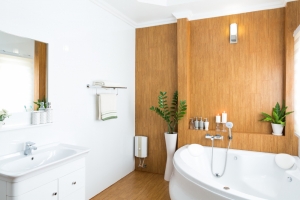Nothing beats the comfort of a crackling fire on a chilly night—especially in the Midwest, where Wisconsin winters can be long and unforgiving. Whether you're a seasoned fireplace pro or just getting started, burning firewood safely and efficiently takes more than just throwing logs on a flame. Here are 10 essential tips to make the most of your fireplace this season—including how to pick the best wood, maintain safety, and get the perfect burn every time.
A well-managed fireplace not only adds ambiance to your space but also helps lower heating costs and provides a natural, comforting warmth that modern heating systems simply can't match. With the right techniques and materials, your fire can be more than just beautiful—it can be a safe, eco-conscious, and high-performing part of your home.
1. Always Use Kiln-Dried Firewood
If you want your fire to light quickly, burn hotter, and produce less smoke, kiln dried firewood is the way to go. Unlike seasoned wood, kiln-dried logs are dried in a controlled environment, removing excess moisture and ensuring a cleaner burn. This means less creosote in your chimney and fewer smoke issues indoors.
If you're Googling "firewood near me", make sure you're buying from a reliable source. For high-quality Wisconsin firewood, Best Burn Firewood is a trusted name that offers delivery and pick-up options throughout the state.
2. Start with a Firewood Starter
Getting your fire going should be simple and safe—no newspaper balls or risky lighter fluids required. A dedicated firewood starter or kindling bag makes it incredibly easy to get a clean, hot flame going fast.
Best Burn Firewood even offers kiln-dried kindling, so you know you're starting your fire with wood that's pest-free, dry, and safe to store inside. Kindling is especially important for those new to wood-burning fireplaces or when you're trying to light fires in colder or damper conditions.
3. Choose the Right Type of Firewood
Not all wood burns the same. Hardwoods like oak, maple, and hickory are ideal for fireplace use because they burn longer and hotter. Softwoods, like pine, tend to ignite faster but burn out quickly and can create more creosote buildup.
If you're buying bundled firewood for convenience or resale, always check the species mix to make sure you're getting top-notch hardwoods.
4. Know How Much Firewood You Need
Are you burning wood daily or just on cozy weekends? Understanding your usage can help you order the right amount of firewood—and avoid overpaying or running out. Curious about how much is in a cord?
Check out this guide on how much firewood is in a cord? to understand the difference between a full cord, face cord, and other common firewood measurements.
Also, consider how much storage space you have. If you're limited on space, bundled firewood might be the most efficient option for occasional use.
5. Store Your Wood Properly
Firewood should always be stored off the ground, ideally in a covered space with good airflow. This keeps your wood dry and prevents it from absorbing ground moisture or becoming a home for pests.
Use a firewood rack, pallets, or a woodshed to keep things organized and protected from snow and rain. If stored correctly, kiln-dried firewood can maintain its quality for many months.
6. Inspect and Clean Your Chimney Regularly
Creosote buildup is one of the top causes of chimney fires. Having your chimney inspected and cleaned at least once a year (more often if you burn frequently) is a key part of fireplace safety.
Even when using high quality firewood, regular chimney maintenance is a must. Many chimney sweeps offer affordable seasonal services and will check for cracks or hazards while cleaning.
7. Never Burn Trash or Treated Wood
It might be tempting to toss in cardboard, painted wood, or old furniture, but these materials can release toxic fumes and damage your fireplace. Stick to natural, untreated firewood only—preferably kiln-dried.
Burning clean wood isn't just about performance—it's also about health and safety for everyone in your home.
8. Use a Fireplace Screen or Glass Doors
A sturdy screen or glass door acts as a barrier to prevent sparks and embers from jumping into your living space. It also helps keep pets and kids safe.
Glass doors can also improve energy efficiency by reducing heat loss when the fireplace isn't in use, while still allowing you to enjoy the view of the fire.
9. Don't Overload the Fireplace
Overstuffing your firebox can restrict airflow, making the fire burn inefficiently and creating more smoke. Use a moderate amount of logs—and always leave room for air to circulate.
Remember: More wood doesn't always mean more heat. A well-stacked fire with airflow burns more completely and provides better warmth.
10. Let the Fire Burn Out Naturally
At the end of the evening, let your fire die down on its own. Don't douse it with water unless absolutely necessary, as this can damage your firebox and chimney liner. Once cool, scoop out the ashes and store them in a metal container.
Hot ashes can stay warm for hours, so be cautious when cleaning up. Ashes can actually be repurposed in compost or as an ice-melter in winter.
Final Thoughts
Using your fireplace safely and effectively is all about preparation, quality firewood, and regular maintenance. By choosing kiln-dried Wisconsin firewood from a trusted supplier like Best Burn Firewood, you can enjoy a warmer, cleaner, and more enjoyable fire all season long.
Whether you're buying for your home, stocking up with bundled firewood for your store, or just curious about how much firewood is in a cord, the key is making informed choices. And don't forget your firewood starter to get that first spark going strong.
If you're new to wood burning, take the time to educate yourself and get the right tools and materials. With just a few smart practices, your fireplace can become one of the most loved and relaxing features in your home.
Stay cozy, stay safe, and enjoy every minute by the fire!






